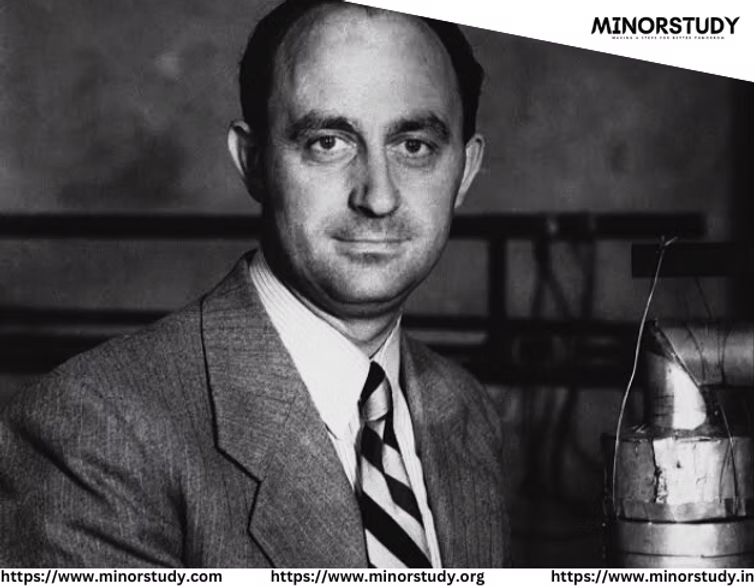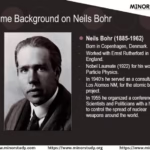Enrico Fermi: Father of Nuclear Physics
Full Name: Enrico Fermi
Born: September 29, 1901, Rome, Italy Died: November 28, 1954, Chicago, Illinois, USANationality: Italian-AmericanField: PhysicsKnown For: Fermi Paradox, Fermi-Dirac Statistics, Development of the First Nuclear Reactor, Contribution to the Manhattan ProjectAwards: Nobel Prize in Physics (1938)
About Enrico Fermi
Enrico Fermi was one of the most influential physicists of the 20th century, making groundbreaking contributions to the development of nuclear physics, quantum theory, and statistical mechanics. Known as the “father of nuclear physics,” Fermi’s work led to the first controlled nuclear chain reaction and helped lay the foundation for the development of nuclear energy.
Key Contributions
Fermi-Dirac Statistics:Fermi formulated a statistical model for particles that obey the Pauli exclusion principle, such as electrons, protons, and neutrons, now known as Fermi-Dirac statistics. This concept is essential in explaining the behavior of fermions, which are the building blocks of matter.
The Fermi Paradox:The Fermi Paradox refers to the apparent contradiction between the high probability of the existence of extraterrestrial life and the lack of evidence for, or contact with, such civilizations. This concept, coined by Fermi in a casual conversation, is still a subject of debate in astrophysics and the search for extraterrestrial intelligence.
Neutron Induced Radioactivity:Fermi’s early work on neutron interactions led to the discovery that neutrons could cause radioactivity in certain elements. This discovery was a major step in understanding nuclear reactions.
The First Nuclear Reactor (Chicago Pile-1):Fermi played a pivotal role in the development of the first nuclear reactor, Chicago Pile-1, which achieved the world’s first controlled nuclear chain reaction on December 2, 1942, as part of the Manhattan Project. This milestone was a critical step in the development of nuclear power and weaponry.
The Manhattan Project:Fermi worked on the Manhattan Project, the U.S. project that developed the atomic bomb. He was instrumental in the design and construction of the first atomic reactors, which were essential for producing the plutonium used in the atomic bombs dropped on Japan.
Fermi’s Golden Rule:Fermi developed a principle in quantum mechanics that describes the transition rate for a particle to move between states, particularly in the context of particle decay and absorption. This rule has applications in atomic and nuclear physics.
Historical Significance
Enrico Fermi’s contributions to physics, particularly in nuclear science, were transformative. His work on the nuclear reactor revolutionized energy production and weaponry. His research into neutron interactions and radioactivity contributed greatly to our understanding of nuclear processes and led to advances in both civilian and military technology.
Fermi’s involvement in the Manhattan Project and his leadership in developing the first nuclear reactors were crucial in the creation of nuclear energy and atomic bombs. His legacy is still felt today in various fields of science, including nuclear energy, astrophysics, and quantum mechanics.
Interesting Facts
Nobel Prize in Physics (1938):Fermi was awarded the Nobel Prize in Physics in 1938 for his work on induced radioactivity, particularly his discovery of nuclear reactions brought about by slow neutrons.
Immigrant to the United States:In 1938, Fermi moved to the United States to escape the growing threat of fascism in Italy. His emigration was a key turning point in the development of nuclear physics in the U.S.
Teaching Legacy:Fermi was known for his excellent teaching abilities. He trained many students who would go on to make significant contributions to science. His students included Nobel laureates such as Leon N. Cooper and Robert Oppenheimer.
Fermi’s Curiosity and Insight:Fermi was famous for his ability to make rough calculations quickly and accurately. He would often use his insight to estimate quantities and solve problems without needing detailed data. This led to the famous “Fermi problems” in which students are asked to estimate quantities based on limited information.
The Fermi Laboratory:The Fermi National Accelerator Laboratory (Fermilab), located in Batavia, Illinois, is named in his honor. It is one of the most important centers for research in particle physics and high-energy physics.
Why Fermi Was Important
Enrico Fermi is remembered as one of the most important scientists of the 20th century. His work not only advanced nuclear physics but also laid the foundation for nuclear power and medicine. His contributions helped to shape the scientific landscape and influenced future generations of physicists and engineers.
The development of the first nuclear reactor under his guidance directly led to the use of nuclear energy for peaceful purposes, such as electricity generation, and for the creation of nuclear weapons, fundamentally changing global geopolitics.
Blessings to Society
Fermi’s work continues to benefit society in multiple ways:
Nuclear Power: Fermi’s research on nuclear reactors led to the development of nuclear power plants, which provide a significant source of energy worldwide.
Medical Applications: His work contributed to advances in medical technology, such as cancer treatment using radiation.
Space Exploration: Fermi’s research on cosmic rays and his work on particle accelerators have furthered our understanding of the universe, contributing to space exploration and astrophysics.
Observance and Themes
Nuclear Physics: Fermi’s work has a lasting impact on the field of nuclear physics and energy. His contributions are taught to students in physics and engineering programs globally.
Scientific Curiosity: Fermi’s inquisitive nature and ability to approach complex problems in simple, practical ways set an example for future scientists and researchers. His legacy encourages future generations to pursue answers to the fundamental questions of nature.
Conclusion
Enrico Fermi was a brilliant physicist whose work in nuclear physics, quantum mechanics, and particle physics revolutionized the 20th century. His pioneering achievements, especially in the development of nuclear reactors, helped shape the modern world, leaving a lasting impact on both scientific knowledge and technological advancements.








